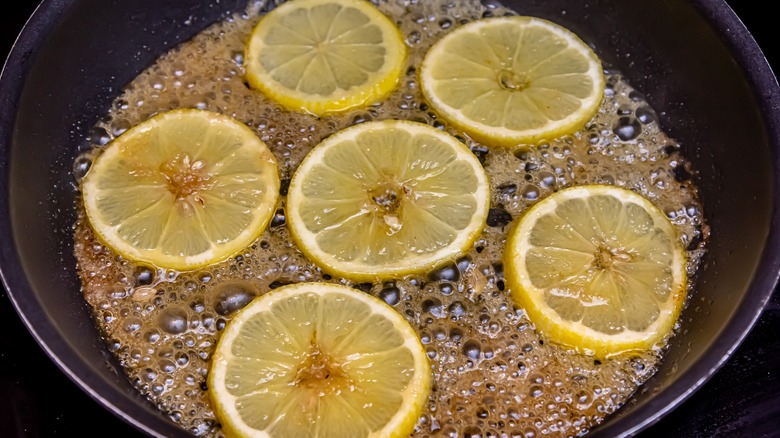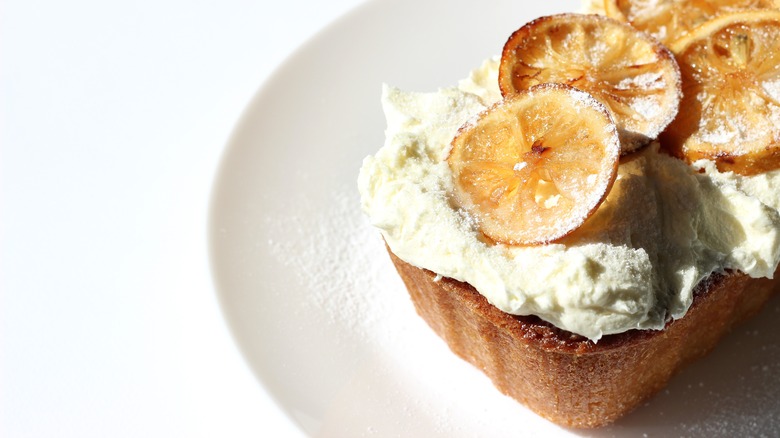We Need To Stop Sleeping On Caramelized Lemons
We add lemon juice to a salad dressing to balance it out with some acidity. We garnish cooked fish with a delicate squeeze to compliment the dish. We include some zest in a dessert recipe to brighten it up. A little bit of fresh lemon can go a long way, which is why this fruit always seems to be a small addition or even an afterthought and rarely a star ingredient.
Everyone knows lemons are extremely acidic and tart, so thinking about eating a whole slice is a scrunchy-face-inducing thought. But cooked lemons are a completely different story — and caramelized lemons are truly something special.
In the same way that we'd caramelize an onion to add sweetness and depth to a savory dish or caramelize a banana for a sugary, decadent dessert, we can caramelize a lemon to add a delicious, unique dimension to any dish, savory or sweet. We've been sleeping on them for far too long, and it's time to wake up.
How do you caramelize a lemon and what does it taste like?
To caramelize a lemon, choose your cooking fat (olive oil or butter will work nicely) and layer it in a frying pan over medium-low heat. Slice the whole lemon into thin rounds, and arrange them evenly so that every slice has good contact with the pan. Flip a few times until the lemon dissolves and softens and each side is deeply browned. If you want a sweeter result, add a bit of sugar or honey while caramelizing.
There are three elements of a lemon that contribute to its flavor: its pulp, its pith, and its rind. The pulp is where its juice comes from, which is predominantly what gives lemons their citrusy, sour, and acidic taste. The pith, which is the white, spongy inner layer covering the pulp, is very bitter. And the rind, or outer peel, contains the fruit's flavorful oils — this is where that bright, "lemony" flavor is found.
The beauty of a caramelized lemon is that you get to taste the flavor profiles of every element of the fruit. When you cook the whole lemon down until it's deeply browned and caramelized, its juice evaporates, and its rind softens. Some of its tartness and bitterness are replaced with toasty sweetness, but its quintessential flavors remain. It's transformed it into something new and complex that's rich, intense, and delicious on just about anything.
Use caramelized lemon to amp up sweet and savory dishes
If you're wondering what dishes will work well with caramelized lemon, the answer is a whole lot of them — there are many ways to use them to add an extra layer of dimension to sweet and savory recipes. Here are some ideas for both that you can try at home.
For something sweet, try adding caramelized lemons to your cake recipes to level up the flavors. You can chop them up into small pieces and mix them into a batter for things like financiers or pound cake, or use them in round slices for something like an upside-down caramelized lemon cake. You can also layer them on as a flavorful topping for baked goods like sweetened breads, tarts, and cheesecake, or simply mix a few small pieces into vanilla ice cream to liven it up.
Caramelized lemons also work wonderfully in many savory recipes, whether it's pasta, seafood, or both — like this pasta with crispy squid and lemon. Try them mixed into roasted veggies, layered on top of a piece of fish, or cooked into a skillet-roasted lemon chicken recipe. You can also use caramelized lemons to make sauces and dressings, like caramelized lemon butter for pasta and rice or caramelized lemon vinaigrette for salads.



